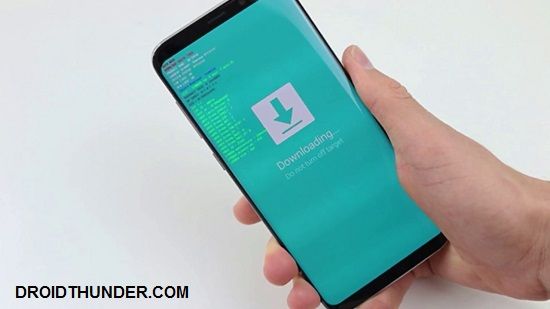Boot Samsung Galaxy S9 into Download Mode using our easy steps tutorial. Launched in March 2018, Samsung Galaxy S9 is a flagship smartphone which is also a successor of the last years Samsung Galaxy S8. Curved glass panels on the front and back, high power camera on the back, high-end processor, and long last battery life.
Some of its more specs include 5.8 inches of Super AMOLED screen with 1440 x 2960 pixels of resolution, Octa-core Qualcomm SDM845 Snapdragon 845 Processor with 256 GB of internal storage and 4 GB of RAM. It was launched with the all-new Android 8.0 Oreo operating system. In today’s article, we’ll discuss some easy steps on how to boot Galaxy S9 into Download Mode.
Download mode is a special state or we can say a sub-system of an Android phone and is mainly used to flash stock firmware through official means. Once you enter your Galaxy S9 into download mode, the system of your device will boot from external sources instead of the stock bootloader which will directly help you to replace the stock ROM on your device.
For entering into downloading mode, your phone doesn’t have to have root access. Download mode, also called as Odin mode can be entered on any smartphone or tablet irrespective of whether it is rooted or unrooted, whether it has custom ROM or stock ROM installed. To confirm that you’ve successfully booted your Galaxy S9 into download mode, you’ll see a black/blue screen with an Android image in it which says “Downloading”.
Entering Galaxy S9 into download mode is one of the easiest tasks that any Android user can implement, as you just need to follow any of the instructions mentioned below. Here in this step by step guide, we’ll discuss four important methods on how to easily enter Galaxy S9 into download mode with or without keys.
How to Enter Samsung Galaxy S9 into Download Mode
Here we have mentioned 4 different ways to enter into download mode. You can refer to anyone of them. Note that the below-mentioned methods apply to all variants of Samsung Galaxy S9 including SM-G9600, SM-G960F, SM-G960T, SM-G960N, SM-G960U, SM-G960W, SM-G960FD and SM-G9608.
Method 1: Using Hard Keys
- Power off your Samsung Galaxy S9 completely until it vibrates.
- Press and hold the Volume Down key + Bixby button + Power button simultaneously.
- Leave all the keys as you see the warning message window.
- Now just press the Volume up button to continue.
- This will directly land your Galaxy S9 into download mode.
- That’s all! You’ve successfully booted into download mode using hard keys.
Method 2: Using ADB commands
- Enable the USB debugging mode on your device.
- Also, enable OEM unlocking and Advance reboot mode from Developer options.
- Download and install ADB and Fastboot setup on your PC.
- Then using USB cable, connect your Galaxy S9 to PC.
- Launch Command window on your PC. For doing that, hold the Shift button and right mouse click anywhere on your PC.
- You’ll see a list of options from which select Open command window here option.
- This will launch the command prompt window.
- Now, type the following command in the command window and press enter key:
adb devices
As soon as you press enter key, you’ll see a message saying ‘List of devices attached’ along with some random numbers.- This will confirm that your Galaxy S9 has successfully connected to your PC.
- If such a thing doesn’t happen, then re-install device drivers, enable USB debugging mode, and try again.
- If the problem persists, try changing USB cable or even the USB port.
- Now to boot your Samsung Galaxy S9 into download mode, type the following command in the command window and hit enter key:
adb reboot download
- As soon as you press enter key, your Galaxy S9 will enter into download mode.
Method 3: Using Terminal Emulator (Requires ROOT)
Terminal Emulator app helps you in accessing the Android’s built-in Linux command-line shell.
- Download and install Terminal Emulator App.
- Launch Terminal Emulator App.
- Type this command in it and press enter key:
su
- As soon as you hit enter key, a popup will appear to grant Superuser permissions.
- So click on Grant option.
- On the next line type the following command and press enter key:
reboot download
- As soon as you hit enter key, your Galaxy S9 will boot into downloading mode.
- Great! You’ve successfully booted your Galaxy S9 into download mode using Terminal Emulator App.
Method 4: Using Quick Reboot App (Requires ROOT)
Quick Reboot app provides advanced reboot options to boot your Galaxy S9 into download mode, recovery mode, normal reboot, fast reboot, safe mode, and much more. This method also requires root access on your phone.
- Download and install the Quick Reboot app.
- Launch the Quick Reboot app.
- Tick the ‘I have read and accept the terms’ and click on confirm.
- To enter into downloading mode, click on the Fastboot mode option.
- Then Tap on Yes to confirm.
- As soon as you click on Yes, a popup will appear to grant Superuser permissions.
- So hit the Grant option.
- That’s all! You’ve successfully booted your Galaxy S9 into download mode using the Quick Reboot app.
How to Exit (get out of) Download Mode
- For Android phones with a removable battery, you just need to open the back panel, remove and re-insert the battery and then normally start the phone by pressing the Power button.
- In the case of non-removable battery phones, long press + hold the Power button to exit the download mode and restart the device.
- For phones with Android 6.0 Marshmallow and above OS, Google has introduced a new process to exit the Download mode. Press and hold Power button + Volume Down key simultaneously until your device reboots.
